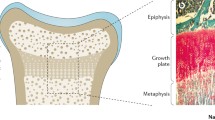Abstract
Normal and rachitic, skeletally immature arctic foxes (Alopex lagopus) were subjected to physical examination, roentgenographic studies, and in some cases histologic studies. The involved animals had active rickets coupled with antecedent normal diaphyseal bone formation. Evaluation of all the long bones showed highly variable manifestations of the disease, which undoubtedly reflect different rates of physeal endochondral transformation and metaphyseal remodeling. Histologic examination showed distinct patterns of widening of the physes and variable osteodystrophy in the trabecular and cortical bone of the metaphyses and epiphyseal ossification centers. These aforementioned factors certainly would necessitate different regional calcium needs and, therefore, different regional responses to an overall calcium deficiency. The physes involved in the most rapid growth rates in this period showed the most widening of the growth plate, and the most dystrophic changes in the metaphysis. Skeletal injuries, including metaphyseal fractures and slow-down of longitudinal growth (particularly in the ulna) were also evident. Because of apparent dietary differences in the affected and normal fox kits, this juvenile-onset disease was presumed due to calcium-deficient intake following weaning. To the best of our knowledge this is the first report of spontaneously occurring rickets in a wild animal in its natural habitat. There are several possible mechanisms for the variable widening of the physis and the loss of bone mineralization in these fox kits: calcium-deficient diet, binding of calcium in the bowel by high phosphorus intake, secondary hyperparathyroidism, and vitamin A toxicity.
Similar content being viewed by others
References
Breshau RC (1957) Hypervitaminosis A. Arch Pediat 74:139 and 178
Bullock BC, Bowen JA (1966) Rickets and osteomalacia in squirrel monkeys Fed Proc 25:533
Capen C (1975) The calcium regulating hormones. In: McDonald CE (ed) Veterinary endocrinology and reproduction. Lea and Febiger, Philadelphia, p 62
Conlogue GJ, Foreyt W, Hanson AL, Ogden JA (1979) Juvenile rickets and hyperparathyroidism in the arctic fox. J Wildlife Dis 15:563
Dämmrich K (1967) Rachitis and osteodystrophia fibrosa gencralisata. Zentralbl Vet Phys Endo Biochem 14:597
Dietrich RA, Venpelt RW (1972) Juvenile osteomalacia in a coyote. J Wildlife Dis 8:146
Fiennes RNTW (1974) Problems of rickets in monkeys and apes. Proc R Soc Med 67:309
Freedman MT, Bush M, Novak GR, Heller RM, James AE, Jr (1976) Nutritional and metabolic bone disease in a zoological population. Skeletal Radiol 1:87
Frye FL (1973) Husbandry, medicine and surgery in captive reptiles. VM Publishing Company, Bonner Springs
Gorham JR, Peckham JC, Alexander J (1970) Rickets and osteodystrophia fibrosa in foxes fed a high horsemeat ration. J Am Vet Med Assoc 156:1331
Graham DL (1976) Malnutrition in captive birds of prey. In: Page LA (ed) Wildlife diseases. Plenum Press, New York, p 89
Graham-Jones O (1964) Further thoughts on a metabolic disease of lions: is it secondary hyperparathyroidism? Tijdschr Diergenesskd 89:Suppl 1, 83
Hunt RD, Garcia G, Hegsted DM (1966) Vitamin D requirement of New World primates. Fed Proc 25:545
Kooh SW, Fraser D, Reilly BJ, Hamilton JR, Gall DG, Bell L (1977) Rickets due to calcium deficiency. N Engl J Med 297:1264
Krempien B, Mehls O, Ritz E (1974) Morphological studies on pathogenesis of epiphyseal slipping in uremic children. Virchows Arch [Pathol Anat] 362:129
Lehner NDM, Bullock BC, Clarkson TB, Lofland HG (1966) Biological activity of vitamins D2 and D3 fed to squirrel monkeys. Fed Proc 25:533
Maltz WE, Fish MD, Holliday MA (1970) Calcium deficiency rickets and the renal response to calcium infusion. Pediatrics 46:865
Mankin HJ (1974) Rickets, osteomalacia and renal osteodystrophy. Parts I, II. J Bone, Joint Surg [Am] 56:101
Mehls O, Ritz E, Krempien B, Gilli G, Link K, Willich E, Scharer K (1975) Slipped epiphyses in renal osteodystrophy. Arch Dis Child 50:545
O'Brien TR, Morgen JP, Suter PF (1971) Epiphyscal plate injury in the dog: a radiographic study of growth disturbance in the forelimb. J Small Anim Pract 12:19
Ogden JA, Conlogue GJ, Jensen P (1978) Radiology of postnatal skeletal development. I. The proximal humerus. Skeletal Radiol 2:153
Ogden JA (1979) Development and growth of the musculoskeletal system. In: Albright JA, Brand RA (eds) Scientific basis of orthopaedics. Appleton-Century-Crofts, New York, p 145
Ogden JA (1981) Chondro-osseous development and growth. In: Urist M (ed) Fundamental and clinical bone physiology. JB Lippincott, Philadelphia
Price DA (1970) Dogs need more than meat. J Am Vet Med Assoc 156:681
Siegel IM (1973) Orthotic treatment of tibiotarsal deformity in an elephant. J Am Vet Med Assoc 163:544
Tomson FN, Lotshaw RR (1978) Hyperphosphatemia and hypocalcemia in lemurs. J Am Vet Med Assoc 173:1103
Tsang RC, Donovan EF, Steichen JJ (1976) Calcium physiology and pathology in the neonate. Pediatr Clin North Am 23:611
Walker ARP (1955) Does a low intake of calcium cause or promote the development of rickets? Am J Clin Nutr 3:114
Walker ARP (1972) The human requirement of calcium: should low intakes be supplemented? Am J Clin Nutr 25:518
Wallach JD (1970) Nutritional diseases of exotic animals. J Am Vet Med 157:583
Wallach JD (1971) Environmental and nutritional diseases of captive reptiles. J Am Vet Med Assoc 159:1632
Author information
Authors and Affiliations
Rights and permissions
About this article
Cite this article
Ogden, J.A., Conlogue, G.J. Spontaneous rickets in the wild arctic fox Alopex lagopus . Skeletal Radiol 7, 43–54 (1981). https://doi.org/10.1007/BF00347171
Issue Date:
DOI: https://doi.org/10.1007/BF00347171




